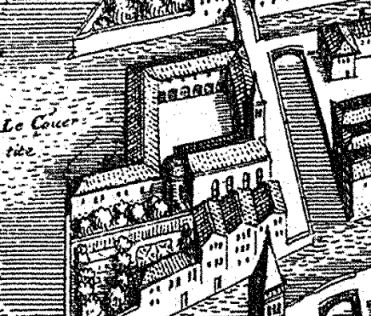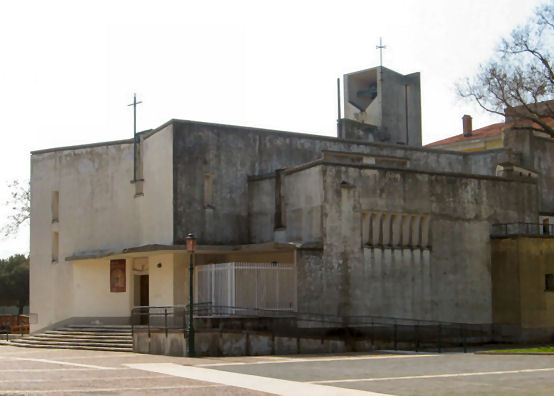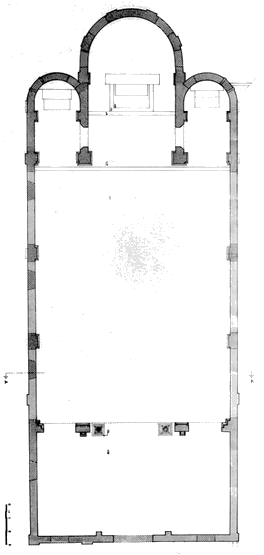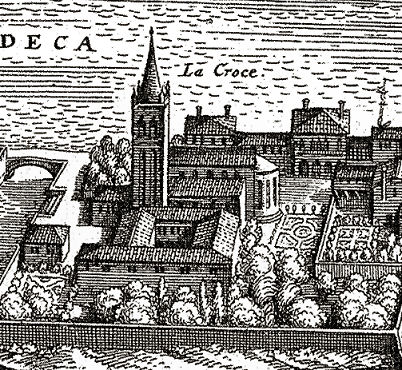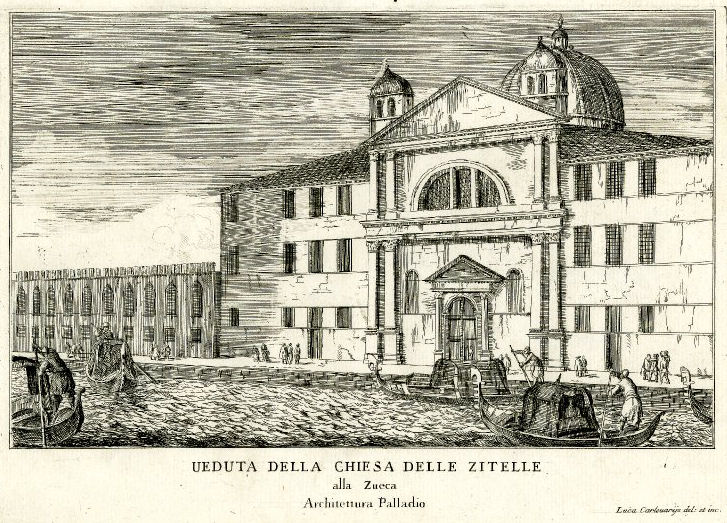|
History
Fiorenza Corner and Teodosia Scripiana built a church and hermitage
dedicated to Santa
Maria degli Angeli, which was given to Fra Bonaventura degli Emmanueli and
his Capuchins in 1541. They were expelled five years later by the
heretic Fra Bernadino Ochino, finding refuge in the nearby (now lost) monastery
of
Sant'Angelo, and then returning here in 1548 when the monastery was destroyed and
the heretic expelled.
A new church was commissioned from Palladio by the Republic to
give thanks for the end of the 1575/7 plague (which killed 50,000 people but which was not
as bad as the one of
1630-31 which took 46,000 people, 30% of Venice’s population, and
which resulted in the building of the
Salute).
Other sites considered included the Clarissan convent of Santa Croce and
San Vidal. The church of the Redentore (Redeemer) was built for ceremony,
on the site of the church of San Jacopo. The first stone was laid on May
3rd 1577, with consecration taking place on September 27th 1592. The
project had been supervised by Antonio Da Ponte, the proto of the Salt
Office. Palladio had died in 1580.
The church was assigned to the Capuchin Order, an order of observant
Franciscans, who then built a new monastery
next door.
Palladio's original design was
for a centrally-planned church like the Pantheon, but this was rejected for
being too pagan. What was
eventually built is more longitudinal and reckoned to be Palladio's finest
church. The
high and wide staircase and the huge doorway are designed for
processions and the church is made to be seen from afar - the best view being from the
Zattere
opposite. The attached monastery later became a barracks.
The Festival of the Redentore, giving thanks for the end of the plague,
continues. Every year on the third Sunday in July a bridge on barges is
built from the Zattere so that Venetians can make the pilgrimage
previously lead by the Doge and the Signoria. This ritual had been added
to the Dogal calendar just months after the laying of the first stone. The festival is also famous
for the fireworks the night before.
The facade
The high and wide (15 step) stairway leads up to a façade which
reflects the interior - the central three bays under the large pediment
echo the nave, with the wings representing the depth of the side chapels.
In the niches either side of the single entrance are statues of Saint Mark
and Saint Francis. On top of the facade are Faith and
two angels, with Saint Anthony of Padua and Saint Laurence Giustiniani
flanking them lower down. A lead-covered wooden statue of The Redeemer
is on top of the dome's lantern. All very Franciscan in the choice of subjects.
Interior
An unusually uncluttered interior, mostly because of the church belonging to Capuchin monks, a very reformed branch of the
Franciscan Order, who agreed to take it on providing
their observance of vows of poverty was respected. So, no extravagance, no remunerative funerary masses
and monuments, and one elegantly unembellished interior, their choir even
more so. Monumental, high, pale and
airy (due to the many thermal windows) and very Palladian. The wide and aisleless
nave has a barrel vault and three connected barrel-vaulted chapels on each side. Over the crossing there's a balustraded dome, and there are chapels
at each end which contain no altars and were built so that the Doge and Signoria
could sit unobserved by the common herd in the nave. The friar's retrochoir, with its
undecorated wooden stalls, is behind a
curved screen of columns behind the high altar. It lacks the grandeur of
the nave, and indeed of Palladio's choir in San Giorgio Maggiore, due to
the Capuchin's more austere values.
Art highlights
There's some middling art (the two late Tintorettos, from the late
1580s, a
Flagellation and an Ascension, are 'school of' and the
'school of' Veronese looks very like a Tintoretto) so even a more glowing Palma Giovane
Deposition stands out a bit. Recent scholarship has it that the
Tintorettos are largely the work of Jacopo's son Domenico. The Veronese Baptism of Christ
was commissioned for the Stravazino chapel in 1561, during the artist's lifetime but finished and signed by
his brother Benedetto and sons Carlo and Gabriele. In fact the altarpieces in all six nave
chapels (the other two are by Francesco Bassano) have a unifying
dark Tintoretto aspect to them. These chapels tell the story of Christ in
processional order, beginning with
the first chapel on the right, Franceso Bassano's Nativity, along
to a Crucifix over
the high altar. The story continues with Palma il Giovane's Deposition
at the beginning of the left aisle, which sequence ends with an
Ascension by Tintoretto's workshop. The bronze Crucifix, by Gerolamo Campagna,
a close friend of Francesco Bassano, is flanked over the
altar by bronze statues
of Saint Mark and Saint Francis by the same sculptor,
symbolising the partnership between the state and the Capuchins.
The not-often-open sacristy, unmentioned on
the Chorus
info sheet and barely mentioned on the church's own leaflet, is a
definite highlight. It is accessed through the last chapel in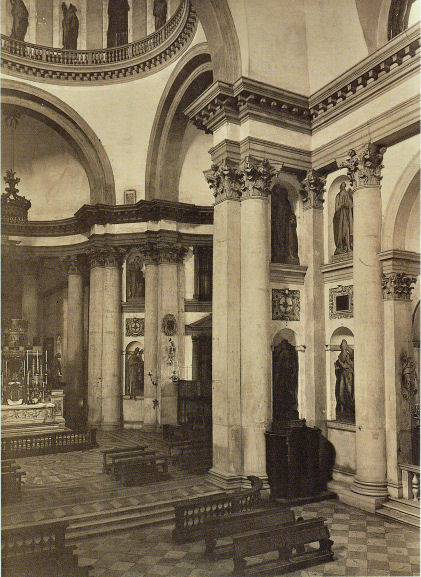 the nave on
the right. A lot of paintings mostly of
the Virgin and Child, including one I especially liked by Rocco
Marconi, another by Alvise Vivarini, another Palma Giovane, and a
Baptism by Veronese. Also lots of reliquaries and twelve creepy 18th-century wax heads of Franciscan saints under glass domes, complete with
real hair and Murano-glass eyes. the nave on
the right. A lot of paintings mostly of
the Virgin and Child, including one I especially liked by Rocco
Marconi, another by Alvise Vivarini, another Palma Giovane, and a
Baptism by Veronese. Also lots of reliquaries and twelve creepy 18th-century wax heads of Franciscan saints under glass domes, complete with
real hair and Murano-glass eyes.
Lost art
In 1618 a Capuchine friar, Paolo Piazza (Padre Cosmo da
Castelfranco) was commissioned to paint a series of monochrome grisaille
figures, in imitation of sculpture, for niches in the nave. These were of
Prophets, Sibyls, The Four Evangelists and The Four Latin
Doctors of the Church. In 1640 The Twelve Apostles by another
friar Padre Massimo da Verona, where created for the drum. All have now
been dispersed, but are visible in a photo from before 1950, see right.
Francesco Bissolo, a pupil of Giovanni Bellini, painted Christ
exchanging the crown of thorns for a crown of gold with Saint Catherine
for the Redentore, but it is now in the Accademia.
A Crucifixion and a Nativity by Andrea Previtali were
transferred from this church to the Accademia in 1897, but must have been
painted for a different church originally.
Campanile 48m (136ft) electromechanical bells
Two minaret-like towers
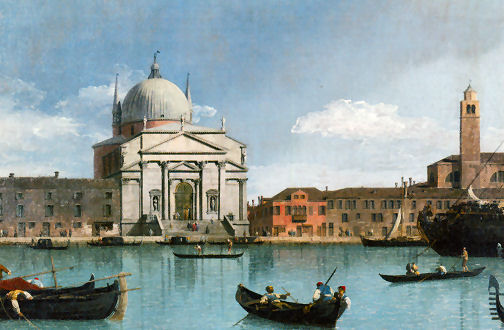
The church in art
Doge Alvise Mocenigo Kneeling Before a Model of Il Redentore of
c.1630 by il Padovannino is in the collection of Marchesa Olga di Cadaval
in Venice
The Church of the Redentore by Canaletto
(see above) from the
Manchester Art Gallery. The demolished church of
San Giacomo della
Giudecca is visible to the right. A version in the Woburn
collection shows San Giacomo much closer to the Redentore.
The Depositing of John Bellini's Three Pictures in the Church of
the Redentore, Venice by J.M.W. Turner shows the three Bellini
paintings arriving in splendid procession in gondolas. This almost
definitely never happened, especially as the paintings in question, which were also mentioned in George Eliot's
Journals in 1864 and William Dean Howells' Venetian Life of
1866 (see below) and by Ruskin, have since been reattributed to Bellini-pupil
Francesco Bissolo and
to Alvise Vivarini.
Il Redentore, an oil painting by Duncan Grant, 1948.
Ruskin wrote
It contains three interesting John Bellinis, and also, in the sacristy,
a most beautiful Paul Veronese.
William Dean Howells wrote
Giudecca produces a variety of beggar, the most truculent and
tenacious in all Venice, and it has a convent of lazy Capuchin friars who
are likewise beggars. To them belongs the church of the Redentore, which
only the Madonnas of Bellini in the sacristy make worthy to be seen.
Opening times
Monday to Saturday: 10.30 - 5.00
A Chorus
Church
As of July 2025 Chorus churches are free to enter,
but you still have to pay to get into the the sacristy.
Vaporetto Redentore
map
The church of San Jacopo which was
demolished to build the Redentore.
|
|
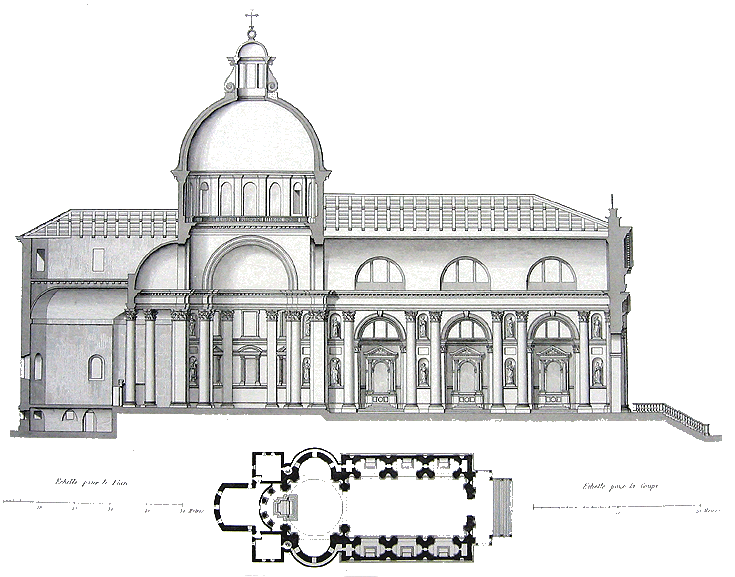
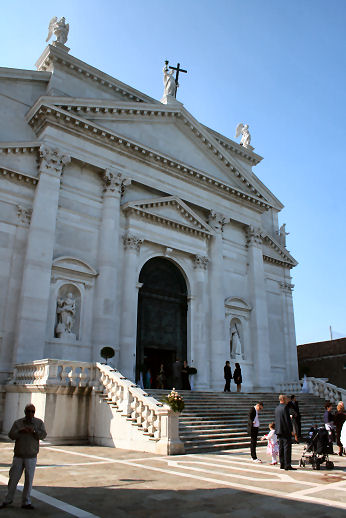
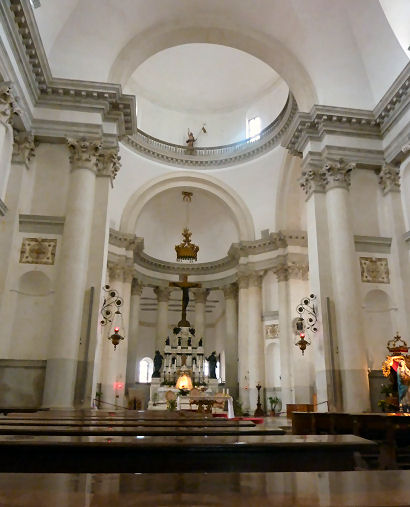
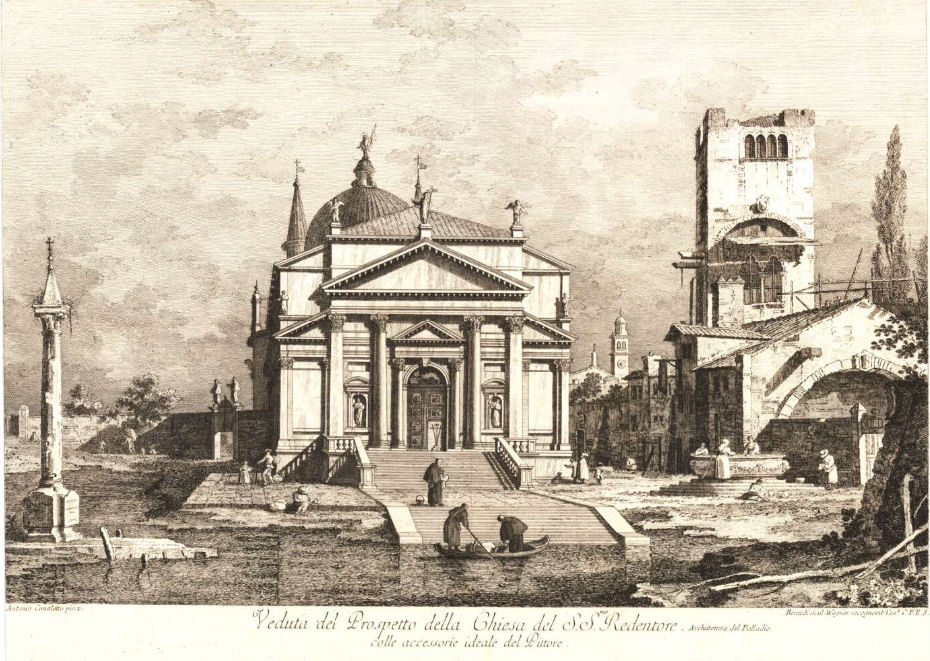
A 1742 print made by Fabio Berardi after
a Redentore-centred capriccio by Canaletto.
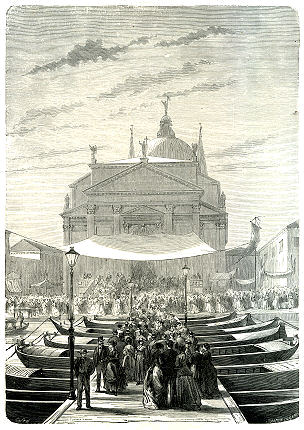
|
|
History
Founded in 865 and initially dedicated to four female saints - Euphemia, Dorothy, Tecla and Erasma, but as time passed the first saint's
name came to dominate. The church became known colloquially as Famia
and was renovated in 952. Reconsecrated in 1371 after rebuilding and
renovated in the second half of the 16th century and again in the
mid-18th, when it acquired new altars and the stucco decoration to the
interior on the upper walls and ceiling.
The church
The portico along the side (visible in the photo right) is by
Michele Sanmicheli and was donated by Giovanni Stucky in 1883. It dates from 1596 and was actually designed as the choir of
the church of Santi Biagio e Cataldo, which was demolished to make way for
the Stucky mill (now a swanky hotel) nearby. The 14th century
Crucifixion above the main door comes from this demolished church too.
Interior
Retains its Veneto-Byzantine form despite later restorations and
decoration, with some columns and capitals dating from the 11th
century.
A surprising interior which has an old shell below, with old columns,
that contrasts strongly with the flouncy rococo decoration above -
all white, pale green and gilt. This effect is accentuated by the
plaster on the lower part of the walls having been mostly chipped away to
reveal the rough brickwork.
Art highlights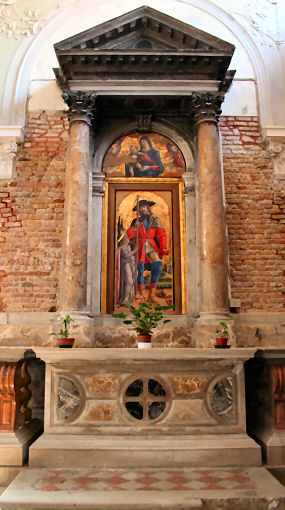
The paintings around the chancel are
uninspiring works by some followers of Veronese. Ceiling frescoes by Giambattista
Canal, a follower of Giovanni Battista Tiepolo. The art highlight is
Saint Roch and the Angel by Bartolomeo Vivarini (see right - originally the
central panel of a triptych which also featured Saint Sebastian and Saint
Louis) with a lunette above of The
Virgin and Child, both restored in 2008. There's also a Morleiter
statue of The Pieta,
where the body of Christ rests on a rock rather than in the usual maternal
lap. This church's factsheet tells us that The Adoration of the Magi by Marieschi
is 'no
longer in place'.
Campanile 10m (33ft) electromechanical bells
The current tower dates from the mid-18th
century, restored in 1883. A drawing by Canaletto
of
around 1730 shows it once had a taller one with a sugar-loaf spire. As
does a detail from a map of 1635 (see below).
Opening times
Mon-Sat: 8.00-12.00 and
3.00-5.00
Sun 3.00-7.00
Vaporetto Sant’Eufemia
map
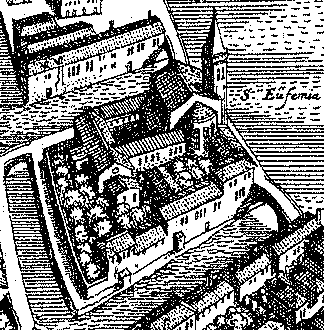
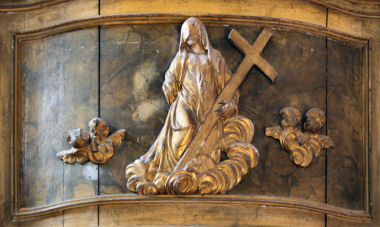
|
|

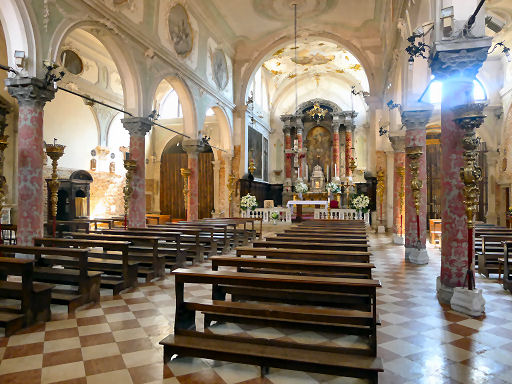
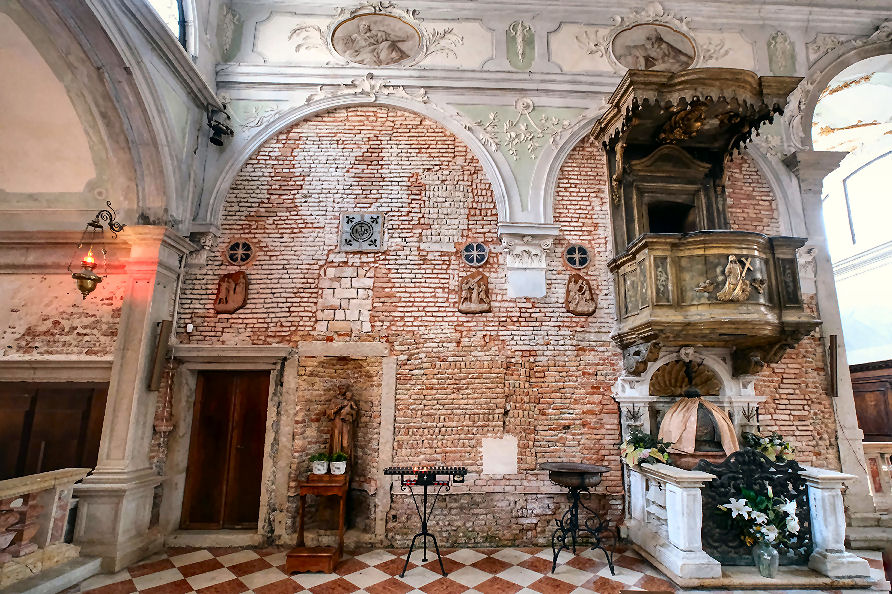
|
History
A convent was established here in 1481 by a Benedictine nun called
Marina Celsi, who had been abbess at San Matteo on Murano and of
Sant'Eufamia on Mazzorbo. The first stone was laid in 1491, with work
completed in 1498. Not consecrated in 1583, it was said that Mauro Codussi may
have had a hand in the design of the church, he having been working at the time on San
Michele in Isola and San Zaccaria, also for the Benedictines, but the
architect is now thought to have been Antonio Abbondi, called Scarpagnino.
Upon suppression by Napoleon in 1806 the nuns moved to San Zaccaria.
The church was stripped and became a warehouse, a barracks, and in 1887 a hospice for
cholera victims. Sold in
1897 to the Herion Brothers who converted it into a textile factory (see
interior photo right with the upper part of the chancel and two
side chapels in the background) which it remained until the 1970s.
The church was restored quite recently for use as office
space for small businesses, the convent buildings having been long since converted to
housing.
Interior
(thanks to Nicola Naccari for the fresh (November 2023) information
and the interior photo)
Whilst the nave contains the offices mentioned above, the chancel
and flanking chapels are free from obstruction and can still be
appreciated (see photo below right). The late-17th-century fresco
in the dome of the chancel is The Virgin with Female Saints
by
Girolamo Pellegrini. Suitably the
saints are all female, including Agnes, Lucy, Mary Magdalene, Giustina,
Margaret and Agatha. It recently underwent restoration work during which a fresco of the Annunciation,
attributed to Francesco Salviati, from 1539/40 was discovered on the
triumphal arch. This work was unknown before the restoration work as it
had been hidden behind a false ceiling since the 17th century.
In the dome's drum, between the windows on its west side, are the
Doctors of the Church, in the apsidal semi-dome is a the Trinity,
with Saint John the Baptist, Saint Peter and a Glory of Angels, and in
the side lunettes below there are Sibyls. In the spandrels are the Four
Evangelists: three of them are by Giuseppe Porta, a pupil of Salviati,
while one, Saint John, is by an unknown hand.
Nothing remains in the chapels
flanking the apse, but in front of the left apse there are some fragments
of the tombstones of Marina Celsi, the Benedictine nun who founded the
convent, and of Benedetto Flangini, the convent's doctor, and hence the
only man that the cloistered nuns would've seen.
Lost art
A small panel showing the top halves of Saints Benedict, Tecla and Cosmas
by Giovanni Buonconsiglio (called Marescalco) from 1497
is now in
the Accademia. It was part of an altarpiece of The Virgin and Child
with Saints which was partially destroyed, perhaps by
a fire here in 1740/41.
The church housed the Tintoretto Virgin and Child with Saints Cecilia,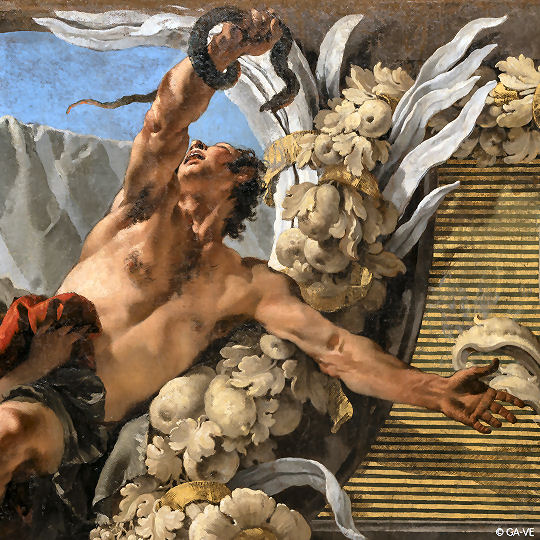 Theodore (or Secondus?), Marina, Cosmas and Damian of c.1579,
originally on the first altar on the left,
also now to be found in the Accademia, and a Crucifixion by him. Also
a Virgin and Child with Saints by Palma Giovane and
a Marriage of Saint Catherine by Padovanino.
Theodore (or Secondus?), Marina, Cosmas and Damian of c.1579,
originally on the first altar on the left,
also now to be found in the Accademia, and a Crucifixion by him. Also
a Virgin and Child with Saints by Palma Giovane and
a Marriage of Saint Catherine by Padovanino.
Giambattista Tiepolo's early Scourge of the Serpents (aka The
Brazen Serpent) (see detail right) now in the
Accademia - the 13 metre long thin painting that was long displayed in Room 11
having been rolled up for
60 years (and boy did it look it!) But it was recently restored and is now
to be found, looking long and impressive at eye level, in the new 17th and 18th-century galleries
there on the ground floor, which opened in August 2021. Painted around 1732/4, it originally
covered the lower portion of the nuns' barco at the back of this church.
It was one of a cycle of paintings filling the
church in the 17th and 18th century which elicited much contemporary
praise. Charles de Brosses praised many of the paintings and Coronelli in
his 1744 guide said 'Here can be seen very many Paintings all by famous
Artists, and these paintings deserve to be seen'. These included four
paintings of Old Testament subjects by Zanchi and a Sacrifice of Saul
painted to hang amongst them by Antonio Molinari. All are long lost,
but drawings for them have been identified.
Also three by
Sebastiano Ricci from c.1716-17 - Solomon Speaking to the People at the Dedication of
the Temple, now in the Duomo in Thiene, Moses Striking Water from
the Rock at Horeb, now in the Cini Foundation, and The
Transportation of the Holy Ark, now in the Brera. Thematically the
works are all Old Testament concentrations on the threats to the ancient
Hebrews, which hung amongst the other Old Testament scenes mentioned above
and chimed nicely with contemporary worries about the upsurge
of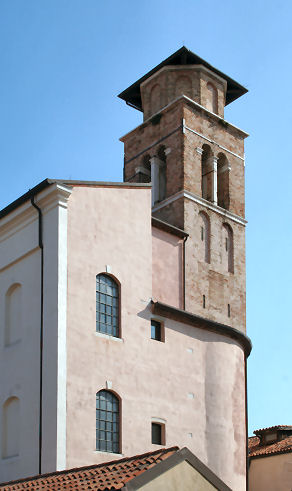 threats to the Venetian state, particularly following their setbacks
during the war in Corfu, stressing as they do the facing of big foes
by strong leaders. threats to the Venetian state, particularly following their setbacks
during the war in Corfu, stressing as they do the facing of big foes
by strong leaders.
Later in the 18th century subjects shifted to the New Testament
with come Pittoni's Multiplication of the Loaves and Fishes and
Angelo Trevisani's Cleansing of the Temple which are both now in a
church in Somaglia.
Bringing the total number of thematically-linked
biblical paintings in this church to thirteen, two less often reported
works are The Finding of Moses by in the Nile by Crosato and The
Centurion Before Christ by Brusaferro.
Campanile
The church still has its spire on the Merian map of 1635 (see
below right).
Convent
Once used by the military, later as a hostel for the homeless
and studio space. Currently being used as housing, with the cloisters
housing an arts and crafts centre (see right).
The church in art
The church appears in Giudecca, a watercolour by John Singer
Sargent. Venice a watercolour view by Clara Montalba in the Walker
Art Gallery in Liverpool features this church's singular campanile.
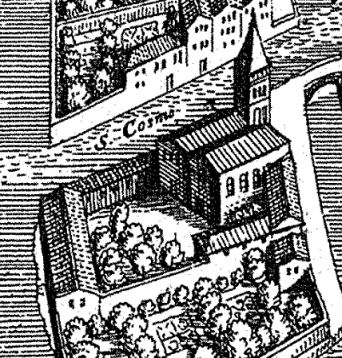
Opening times
It has been suggested that if you ring the doorbell during business hours
and ask nicely admittance might be granted.
Vaporetto Sant’Eufemia
map
Bibliography
Nuns and Reform Art in Early Modern Venice by Benjamin Paul
|
|
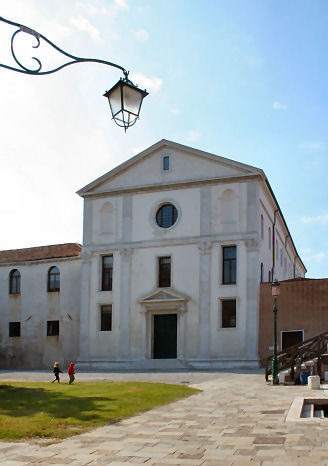

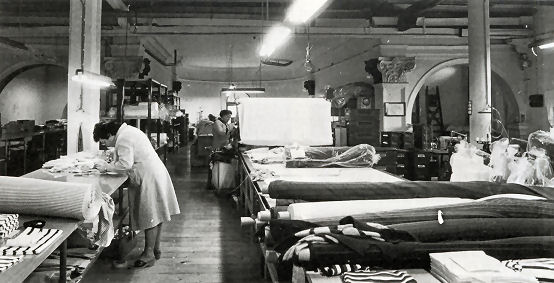
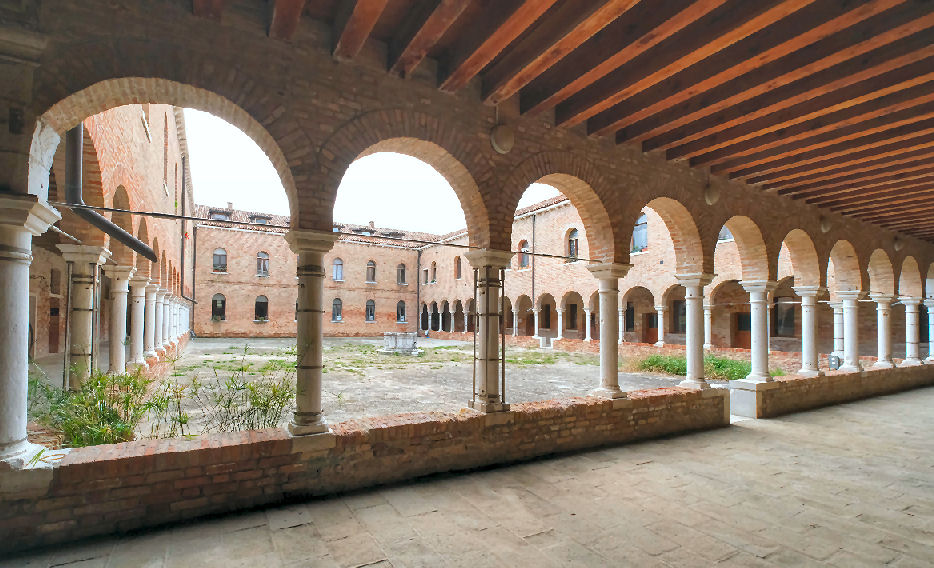
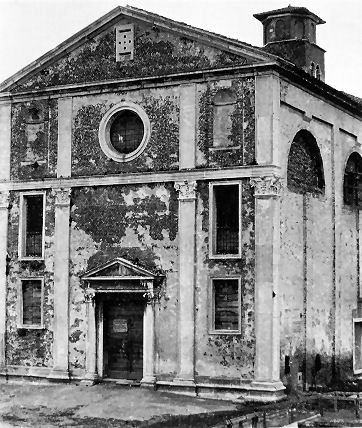
A photo from the late 19th-century showing
the original
windows, including the lunettes down the side.
|
History
The church of Santa Maria della Presentazione is better known as Le
Zitelle, or 'The Spinsters', since here was built a hospice for 'beautiful girls'
from poor families whose beauty was thought to put them in danger of falling into prostitution.
A prevention regime, then, as opposed to the nearby Convertite's concentration on helping
already-fallen women. Poor
young virgins were taken in, some as young as 12, and trained in lace and music making. The
location was to help with their isolation. They were kept protected until they were
18, when they could choose between marriage or the nunnery. If they chose
marriage a husband was found and a dowry was provided. The hospice was
founded by the Jesuit Benedetto Palmio in 1558, with the first forty
women arriving here in 1561, and was patronised by Venetian
noblewomen. Following the expansion of the accommodation from the mid-1560s the
church, arguably based on designs by Palladio of around 1576 for a
different church, was built
by Jacopo Bozzetto from 1581 to 1585. There is an argument that if the
design isn't Palladio's own, it is at least the beginning of Palladianism.
The church
The Palladian façade with its large thermal window is flanked by the wings of the hospice. The buildings
extend around the back with a cloister behind the church. The complex
is now a luxury hotel.
Interior
A small barrel-vaulted vestibule leads to a square nave, the
curved-off corners of which give the impression of an octagon. The girls' choir
galleries, which take form of thermal windows with grills over the side
altars, were reached from the flanking buildings.
Art highlights
There are works here by Palma Giovane, Antonio Vassilacchi (a Greek
painter and pupil of Paolo Veronese, also known as L'Aliense) and Francesco Bassano,
whose Presentation of the Virgin is the high altarpiece. He was one of the four
sons of the better known Jacopo.
The church in art
The Giudecca with the Zitelle by Franceso Guardi, in the National
Gallery in London.
Another version (see below) is to be found in
the Kunsthaus Zurich.
Opening times
The church seems to have been acquired for visits by the company that runs
the
Scala Contarini del Bovolo,
but you have to book in advance.
Update September 2025 Currently covered in scaffolding.
Vaporetto Zitelle
map
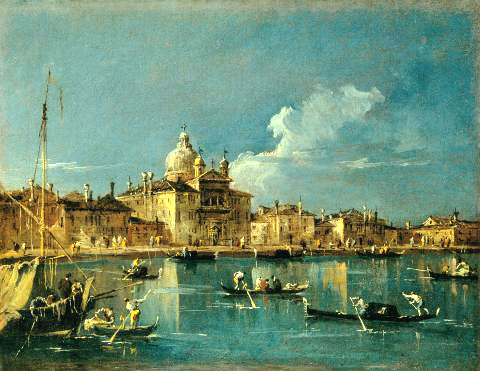
|
|
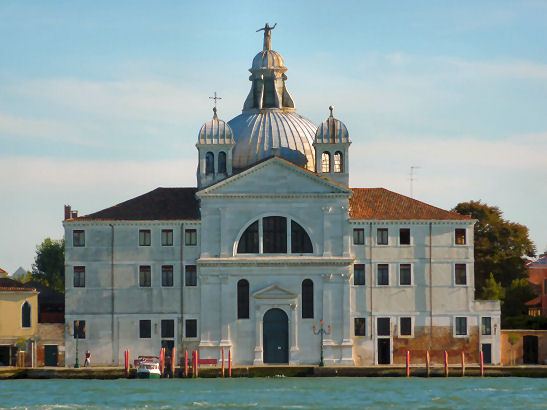
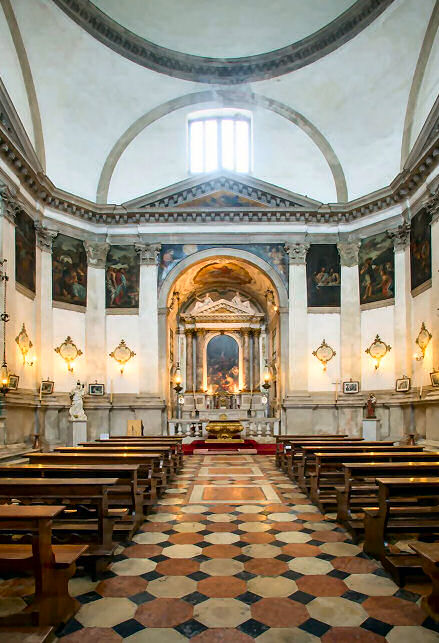
Interior photo
courtesy of the internet.
|
